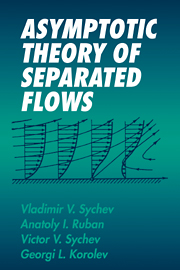Book contents
- Frontmatter
- Contents
- Preface
- Preface to the English Edition
- 1 The Theory of Separation from a Smooth Surface
- 2 Flow Separation from Corners of a Body Contour
- 3 Flow in the Vicinity of the Trailing Edge of a Thin Airfoil
- 4 Separation at the Leading Edge of a Thin Airfoil
- 5 The Theory of Unsteady Separation
- 6 The Asymptotic Theory of Flow Past Blunt Bodies
- 7 Numerical Methods for Solving the Equations of Interaction
- References
- Index
4 - Separation at the Leading Edge of a Thin Airfoil
Published online by Cambridge University Press: 07 October 2011
- Frontmatter
- Contents
- Preface
- Preface to the English Edition
- 1 The Theory of Separation from a Smooth Surface
- 2 Flow Separation from Corners of a Body Contour
- 3 Flow in the Vicinity of the Trailing Edge of a Thin Airfoil
- 4 Separation at the Leading Edge of a Thin Airfoil
- 5 The Theory of Unsteady Separation
- 6 The Asymptotic Theory of Flow Past Blunt Bodies
- 7 Numerical Methods for Solving the Equations of Interaction
- References
- Index
Summary
Experimental Observations
Boundary-layer separation at the leading edge of a thin airfoil is the principal factor that limits the lift force acting on an airfoil in a fluid stream. Jones (1934) was the first to describe this kind of separation. Since that time, many researchers have turned to the experimental study of flow around the leading edge of an airfoil. In addition to a great number of original studies, several surveys have been devoted to this theme. The reviews by Tani (1964) and Ward (1963) can be regarded as the most complete.
Experiments show that as the angle of attack increases the picture of the flow around the airfoil changes in the following way. When the angle of attack is small, the flow over the profile is attached. Then the pressure has its maximum at the stagnation point O of the flow, where the zero streamline divides into two – one branch lies along the lower surface of the airfoil, and the second one bends around the leading edge of the airfoil and then lies along its upper surface. As we move from the stagnation point along the upper branch, the pressure first falls rapidly, reaching a minimum at some point M (Figure 4.1a), and then starts to increase, so that the boundary layer downstream from point M finds itself under the influence of an adverse pressure gradient. Its magnitude increases with growth of the angle of attack, finally resulting in boundary-layer separation, which occurs earlier for smaller relative airfoil thickness.
When the boundary layer separates, one can observe the appearance of a closed region of recirculating flow on the upper surface of the airfoil (Figure 4.1a).
- Type
- Chapter
- Information
- Asymptotic Theory of Separated Flows , pp. 135 - 175Publisher: Cambridge University PressPrint publication year: 1998

